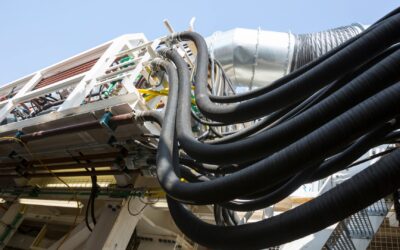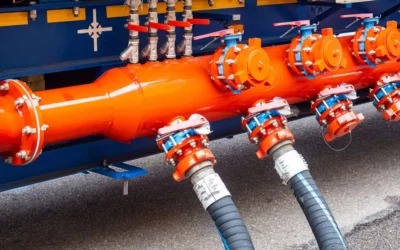Fluid transport is a critical aspect of many industrial operations. From dredging and construction to agriculture and oil and gas, industries rely on efficient systems to move water, chemicals, and other liquids. However, these tasks come with challenges such as pressure resistance, wear and tear, and the need for space-efficient solutions. Selecting the right equipment is crucial for maintaining operational efficiency and minimizing downtime. Among the many options available, flat hoses have emerged as a versatile and innovative solution for fluid transport.
In this article, we’ll explore flat hoses, their design and advantages, the industries they serve, and how they are becoming an essential component in modern industrial applications.
What is a Flat Hose?
Flat hoses are collapsible, flexible tubes designed for efficient fluid transport. Unlike traditional round hoses, flat hoses have a flat profile when not in use, making them compact and easy to store. They are typically made from durable materials such as PVC, rubber, or polyurethane, which provide flexibility and strength.
Key Features of Flat Hoses
- Collapsible Design: Flat hoses remain flat when not in use, minimizing storage space requirements.
- Lightweight: Despite their durability, flat hoses are much lighter than conventional hoses, making them easy to handle and transport.
- Durability: Designed to withstand harsh conditions, these hoses resist abrasion, chemicals, and UV exposure.
- Flexibility: Flat hoses are highly flexible, allowing them to bend and adapt to different terrains and operational needs.
Compared to traditional round hoses, flat hoses offer a unique combination of convenience and resilience, making them an increasingly popular choice across industries.
Advantages of Flat Hoses in Industrial Settings

Flat hoses deliver several advantages that address common challenges in industrial fluid transport. Here are some key benefits:
1. Space-Saving Design
When not in use, flat hoses collapse into a flat shape, significantly reducing their storage footprint. This compact design allows industries to save valuable storage space and transport more hoses in less volume.
2. Durability
Flat hoses are built to endure tough environments. Their materials resist abrasions, harsh chemicals, and UV radiation, ensuring they can perform under extreme conditions without degrading quickly.
3. Efficiency
Designed to handle high-pressure applications, flat hoses maintain a lightweight profile, making them easy to maneuver and install. This speeds up operations and reduces labor costs.
4. Cost-Effectiveness
With their robust design, flat hoses last longer than many traditional options, reducing the frequency of replacements. This durability translates to lower maintenance costs and long-term savings.
Applications of Flat Hoses in Industrial Operations

Flat hoses are used across various industries due to their adaptability and reliability. Below are some of the primary applications:
1. Dredging and Dewatering Projects
In dredging and dewatering, flat discharge hose excels at transporting water, slurry, and sediments over long distances. Their lightweight and flexible design makes them easy to deploy and retrieve, even in challenging environments.
2. Agriculture and Irrigation
Lay flat hose is ideal for transporting large volumes of water to fields and crops. Their collapsible nature allows farmers to easily move and store them during off-seasons, while their durability ensures they withstand exposure to sunlight and chemicals used in agriculture.
3. Construction Sites
On construction sites, flat discharge hose is used for managing wastewater, delivering materials like cement slurry, or draining flooded areas. Their resistance to wear and chemical corrosion ensures they perform reliably in demanding settings.
4. Oil and Gas Industry
The oil and gas sector often requires hoses that can transport fuels and other chemicals without reacting to corrosive substances. Specialized lay flat hose meet the demand, providing a safe and efficient solution.
Selecting the Right Flat Hoses for Your Needs

Choosing the right lay flat hose for your application is essential for optimizing performance and ensuring safety. Consider the following factors:
1. Material Compatibility
Select a hose material that is compatible with the fluid you’ll be transporting. For example, PVC is suitable for water and light chemicals, while a flat discharge hose made of rubber or polyurethane may be better for more abrasive or corrosive substances.
2. Pressure Rating
Ensure the hose can handle the required pressure levels without risk of bursting or deformation. A Flat discharge hose is available in various pressure ratings to suit different industrial needs.
3. Temperature Resistance
For operations involving extreme temperatures, choose a flat discharge hose with appropriate thermal resistance. This will prevent damage and maintain efficiency.
4. Hose Length and Diameter
Match the flat discharge hose length and diameter to your operational requirements. Too small a diameter could restrict flow, while an overly long hose may result in unnecessary pressure loss.
Maintenance Tips for Flat Hoses
Proper maintenance can significantly extend the lifespan of flat hoses and ensure consistent performance. Follow these tips to keep your hoses in top condition:
Regular Cleaning
Proper cleaning after every use is essential to prevent premature wear and damage. Here’s how:
- Flush Thoroughly: After transporting water, chemicals, or other fluids, flush the hose with clean water to remove any residual materials that could corrode or damage the interior lining. For hoses used with chemicals, check the manufacturer’s cleaning guidelines to avoid material degradation.
- Remove Debris: Dirt, mud, or sand lodged inside or on the hose can cause abrasions when the hose is coiled or uncoiled. Gently rinse and clean the hose exterior to eliminate such debris.
- Dry Before Storage: Ensure the hose is completely dry before storing it. Excess moisture can promote mold growth, material degradation, or rusting in metal couplings.
Proper Storage
Flat hoses are designed for flexibility, but improper storage can cause kinks, cracks, or warping over time. Follow these storage best practices:
- Use Hose Reels or Racks: Invest in hose reels or dedicated racks to neatly store flat hoses. Rolling the hose onto a reel prevents sharp bends or kinks that could weaken its structure.
- Avoid Sunlight Exposure: Extended exposure to UV rays can degrade the material, making the hose brittle and prone to cracks. Store the hose in a shaded, cool area. UV-protected hose bags or covers can also offer additional protection.
- Keep Away from Chemicals and Heat: Store hoses in an environment free from exposure to chemicals, oils, or excessive heat sources, as these can corrode the material or reduce flexibility.
- Organize by Size and Application: Keep hoses organized based on their size and intended use to avoid mixing and damage during retrieval.
Routine Inspections
Regular inspections are vital to catching minor issues before they become major failures. Follow these steps:
- Check for Cracks and Abrasions: Inspect the hose for surface cracks, cuts, or abrasions, especially in high-wear areas like bends and couplings. These weak points can escalate under pressure.
- Look for Leaks or Bulges: Test the hose under low pressure to identify any leaks, bulges, or deformities that indicate internal damage or material fatigue.
- Examine Couplings and Fittings: Inspect metal or plastic fittings for rust, cracks, or loose connections. Damaged couplings can cause leaks or pressure loss during operation.
- Assess Flexibility: Gently bend and stretch sections of the hose to ensure it retains its flexibility. Brittle or stiff areas are signs of material degradation.
- Pressure Test Periodically: For hoses used in high-pressure applications, conduct periodic pressure tests to ensure they meet performance standards.
Additional Maintenance Tips

Here are some bonus tips for ensuring optimal performance:
- Avoid Dragging: When moving flat hoses, avoid dragging them across abrasive surfaces like gravel or pavement, which can cause premature wear. Use hose bridges or protective sleeves for rough terrain.
- Proper Coupling Use: Always use the correct type of couplings and ensure a secure fit. Loose or incompatible couplings can cause leaks or operational failure.
- Pressure Management: Do not exceed the recommended pressure ratings for your hose. Over-pressurizing can cause burst failures or damage the hose lining.
Innovations in Flat Hoses Technology
Advancements in lay flat hoses technology continue to enhance their performance and broaden their applications. Here are some notable innovations:
1. Enhanced Materials
Modern flat hose is benefiting from advancements in material science, which focus on improving their durability, flexibility, and chemical resistance. Key developments include:
- Thermoplastic Elastomers (TPEs): These materials combine the elastic properties of rubber with the durability and processability of thermoplastics. TPEs offer excellent flexibility, high tensile strength, and resistance to abrasion, making a flat hose ideal for demanding applications such as industrial water transfer, mining, and agriculture.
- Advanced Coatings: New polymer-based coatings provide enhanced UV resistance, preventing degradation when exposed to prolonged sunlight. This is particularly important for outdoor use.
- Chemical Resistance: Innovations in composite materials ensure that a flat hose can withstand exposure to corrosive fluids, oils, and chemicals without compromising their structural integrity.
2. Smart Monitoring Systems
The integration of Internet of Things (IoT) technology into flat hose has revolutionized their operational efficiency. Smart hoses are equipped with sensors that monitor critical performance metrics in real time. Key features include:
- Pressure and Flow Monitoring: Sensors embedded in the hose measure flow rates and internal pressure continuously. If any irregularities occur, such as drops in pressure or blockages, operators can take immediate corrective action.
- Leak Detection: Advanced systems can identify micro-leaks early, preventing potential downtime and reducing water or fluid waste.
- Data Analytics: Collected sensor data is often sent to centralized monitoring platforms, where it can be analyzed for predictive maintenance. This minimizes unplanned failures and extends the service life of the hose.
These smart monitoring features are especially useful in industries like firefighting, irrigation, and fluid transportation, where reliability and safety are paramount.
3. Sustainable Manufacturing
Environmental concerns have driven innovation in flat hose manufacturing, resulting in greener products and processes. Key trends include:
- Use of Recyclable Materials: Manufacturers are increasingly adopting materials like recyclable thermoplastics and polyurethane, reducing waste and supporting a circular economy. At the end of their lifespan, these hoses can be reprocessed into new products.
- Eco-Friendly Production Processes: Companies are optimizing production lines to minimize energy consumption, reduce emissions, and eliminate harmful byproducts. For instance, water-based adhesives and coatings are replacing solvent-based alternatives.
- Reduced Carbon Footprint: Innovations in lightweight materials allow the lay flat hose to retain their durability while being easier to transport and handle. This reduces fuel consumption during transportation, further lowering the environmental impact.
These sustainability initiatives align with global efforts to reduce industrial waste and meet environmental regulations.
Applications Benefiting from These Innovations
The innovations in flat hose technology have expanded their use across various industries, including:
- Agriculture: Flexible and durable hoses for efficient water irrigation systems.
- Mining: Chemical- and abrasion-resistant hoses for slurry transport and dewatering.
- Emergency Services: Lightweight hoses with smart sensors for firefighting applications.
- Industrial Applications: Reliable hoses for fluid transfer, chemical transport, and wastewater management.
Why Flat Hose is a Sustainable Choice
The flat hose is not only practical but also environmentally friendly. Here’s why they are a sustainable choice for industrial applications:
Reduced Material Waste
Lay flat hoses are designed for durability and longevity, which means they can withstand harsh industrial conditions such as high pressures, heavy abrasion, and varying weather conditions. Because they are less likely to fail or degrade quickly, businesses replace them less often. This significantly reduces the amount of material waste that ends up in landfills. Compared to rigid alternatives, the extended lifecycle of a flat hose makes them a more sustainable option.
Compact Design
One of the standout features of lay flat hoses is their collapsible and lightweight design. Unlike rigid piping systems, which require significant storage and transport space, flat discharge hoses can be folded and stacked efficiently. This compact nature means fewer transportation trips are needed, reducing fuel consumption and greenhouse gas emissions. It also lowers the costs associated with logistics, helping businesses operate more sustainably while reducing their carbon footprint.
Recyclable Materials
Many modern flat discharge hose is manufactured using advanced materials like thermoplastic polyurethane (TPU), polyvinyl chloride (PVC), or rubber blends, which can often be recycled at the end of their service life. Recycling these materials allows manufacturers to repurpose them into new products, contributing to a circular economy where resources are reused rather than discarded. This reduces the demand for virgin raw materials, conserving natural resources and minimizing environmental impact.
Conclusion
Flat discharge hose has revolutionized fluid transport in industrial applications with their versatility, efficiency, and durability. From saving space and reducing costs to enhancing sustainability, lay flat hoses address key challenges faced by industries today. By selecting the right lay flat hose for your needs and following proper maintenance practices, you can maximize their benefits and ensure long-term performance.
If you’re looking to incorporate lay flat hoses into your operations, contact [Your Company Name] today. We offer a wide range of high-quality flat discharge hose tailored to meet the unique demands of your industry. Let us help you improve efficiency and sustainability with our innovative solutions.




